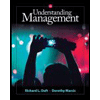Chapter 10 Review Questions Kirandeep Kaur
docx
keyboard_arrow_up
School
Vancouver Community College *
*We aren’t endorsed by this school
Course
BUS500
Subject
Management
Date
Jan 9, 2024
Type
docx
Pages
3
Uploaded by kdhillon2781
Your preview ends here
Eager to read complete document? Join bartleby learn and gain access to the full version
- Access to all documents
- Unlimited textbook solutions
- 24/7 expert homework help
Recommended textbooks for you

Management, Loose-Leaf Version
Management
ISBN:9781305969308
Author:Richard L. Daft
Publisher:South-Western College Pub

Understanding Management (MindTap Course List)
Management
ISBN:9781305502215
Author:Richard L. Daft, Dorothy Marcic
Publisher:Cengage Learning

Recommended textbooks for you
 Management, Loose-Leaf VersionManagementISBN:9781305969308Author:Richard L. DaftPublisher:South-Western College Pub
Management, Loose-Leaf VersionManagementISBN:9781305969308Author:Richard L. DaftPublisher:South-Western College Pub Understanding Management (MindTap Course List)ManagementISBN:9781305502215Author:Richard L. Daft, Dorothy MarcicPublisher:Cengage Learning
Understanding Management (MindTap Course List)ManagementISBN:9781305502215Author:Richard L. Daft, Dorothy MarcicPublisher:Cengage Learning

Management, Loose-Leaf Version
Management
ISBN:9781305969308
Author:Richard L. Daft
Publisher:South-Western College Pub

Understanding Management (MindTap Course List)
Management
ISBN:9781305502215
Author:Richard L. Daft, Dorothy Marcic
Publisher:Cengage Learning
